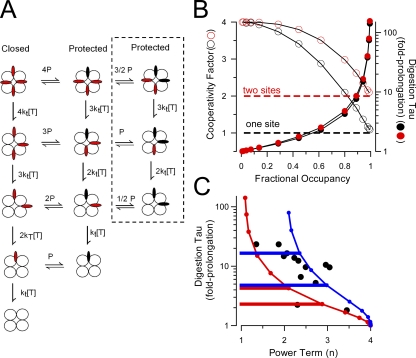Figure 12.
A model in which two N termini can dwell within the antechamber at a time may better account for the data. (A) The two left-hand columns of states correspond to Scheme 1 under conditions of low Po and no inactivation and, therefore, approximate closed-channel conditions for a model in which one N terminus can occupy the antechamber at a time. The additional states highlighted in the dotted rectangle propose that an additional N terminus can also bind, presumably in the antechamber, thereby being protected from digestion by trypsin. Red and black ovoids correspond to unprotected and protected N termini, respectively. (B) Both one- and two-site models were used to simulate the trypsin-mediated removal of inactivation over a range of values of P, the binding constant for the site producing closed-channel–associated protection. Fractional occupancy was calculated as: Pa = pf/(pf+pr), where pf and pr are defined as the rates of binding and unbinding of an N terminus in the antechamber (Table II). Both models predict a similar prolongation of τd (filled circles) with occupancy within the antechamber, whereas the two differ in regards to the limiting power term at high fractional occupancies (open circles). Note that, for the one-site model, the relationship between fractional occupancy, prolongation of τd, and n were plotted incorrectly in our previous report (Zhang et al., 2006), as described in Materials and methods. (C) The prolongation of τd is plotted as a function of the power term for the one-site (red) and two-site (blue) models. The horizontal lines mark the range of prolongations, relative to the case for n = 4, expected for power terms in the range of 2 to 3. The filled black circles correspond to measurements of n and calculations of prolongation of τd for wild-type β2 and mutated β2 constructs, assuming that the digestion rate of β3a most closely reflects digestion of an N terminus without protection in the antechamber. If the rate of digestion of the W4G construct is used as the τd(min), the points are shifted leftward, but still favor the idea that two sites are involved in closed-channel–associated protection.

